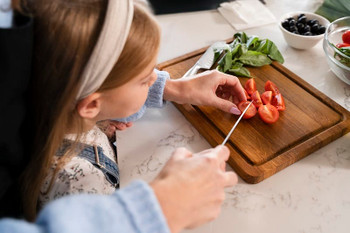The Top 9 Rules for Kids Using Knives
Posted by EKnives on Mar 5th 2024
Your child is showing interest in your knife hobby. Great! It's time to gear up for some serious parent-child bonding. But make sure the rules are clear first so everyone stays safe. Here are the nine rules we believe you should have for your kids when you teach them how to use knives:
- Pass a knife safely. If you teach your child how to handle your OTF or folding knives, show them how to close the knife and let them know that's the proper way to pass it. No one can get cut if the blade is out of the way. If the knife has a fixed blade, teach them that you should always pass knives by the handles first. For kids, though, you probably want to have them sheathed first, too.
- Sheath unused knives. If the blade of the knife you're using doesn't retract, you will want it to stay sheathed when you aren't using it. Sheathing the knife will be the safest way to pass it, but it will also be the safest to stay encased while sitting in case someone accidentally bumps it.
- Teach them their knives. Each knife is a little different. Show them how to open and close their folding knives safely. Teach them where the blade will come out for an OTF knife. Let them become familiar with the knife's intricacies before they even start cutting with it.
- Sit to cut. Before you make any cuts, you will want to sit down. Sitting will help them be much more stable. The only exception to this rule would be when you are sawing, but that might not be a skill you're breaking out at your first lesson.
- Only cut if no one is in their bubble. Have kids imagine they are in a giant bubble. The bubble is as big as their arms and the knife can reach. They should not make any cuts if anyone (besides their adult helper) is in the bubble with them. As soon as someone enters the bubble, they should stop cutting.
- Cut away from your body. Teach kids to always cut carefully, but every cut should be away from their bodies. Don't cut something toward your hand, arm, leg, or stomach. Even the most careful knife wielders can slip; everyone should follow this rule.
- Make slow, little cuts. Making small cuts will help you artistically as you whittle, and it is also safer. Minor cuts are easier to control. You can always cut off more, but you can't take back a large cut where you cut too much. Working slowly will also help you maintain control and avoid dangerous slips.
- Cut with a sharp knife. Dull knives are dangerous. Teach your child to inspect the blade and ensure the edges are smooth and sharp. (Just don't have them test it with their finger!)
- Only use one cutting device at a time. Your kid might be following in your footsteps and starting their own knife collection, but regardless of how many knives you own, teach kids to only have one out at any given time. If you need multiple knives to get the job done, ensure you sheath one before you pull out the next one.
Bonus Rule: Have fun. Knives are dangerous and can be scary, but you don't want to make them anxious around tools, either. Teach them that if they follow the rules, they can keep themselves and others safe.
Best Knives for Learning
Some knives are more accessible to navigate than others. Like the 2024 Microtech LUDT Automatic Folding Knife, a folding knife is a great option. Folding knives are simple but functional and great for starters. If you'd prefer to begin with an OTF knife, the Microtech UTX-70 OTF Automatic Knife might be a good fit. Just note that OTF knives can be a little trickier to handle, so that might be best for an older beginner.
Why Whittle With the Littles?
So, why exactly should you take the time to hand a dangerous tool to the kid in your life? There are actually a lot of benefits to it.
Knives are great tools for kids to learn. Knife handling is a lifelong (and even life-saving) skill.
Whittling with your kids creates a special bonding time.
Showing your kids your knives and sharing them with them will help curb some of their curiosity. They should learn how to handle them from you rather than from sneaking behind your back.
Teaching kids how to handle knives also helps build their dexterity and coordination. It can promote self-confidence and self-identity.
Maybe you wish that someone could have shown you the ropes with knives years ago. If you were lucky enough to have someone in your life who taught you how to handle knives at a young age, you know just how helpful and influential those early lessons were.

